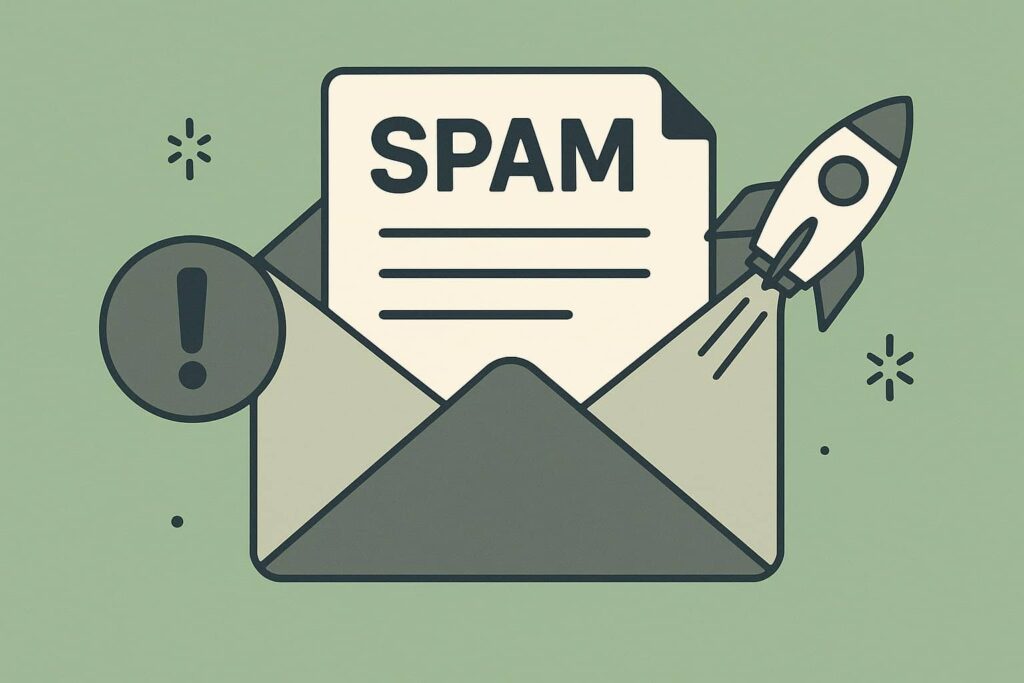Email spam, the unwanted digital plague that has cluttered our inboxes for decades, has evolved from simple promotional messages into sophisticated cyber warfare. What started as annoying advertisements for questionable products has transformed into a complex ecosystem of malicious attacks targeting our personal data, financial information, and digital security.
With artificial intelligence, machine learning, and advanced social engineering techniques, the future of email spam is becoming more dangerous and harder to detect than ever before. From AI-generated phishing campaigns to deepfake video emails, we’re entering an era where spam doesn’t just waste your time – it can devastate your life.
Let’s explore how email spam has evolved, examine the current threats dominating inboxes today, and predict the future of email spam. Like what’s coming next as technology continues to advance.
The Evolution of Email Spam: From Simple Ads to Digital Weapons
Email spam began as a relatively harmless nuisance in the early 1990s when the internet was young and email filters were virtually nonexistent.
Your inbox would fill with unsolicited messages promoting miracle weight loss pills, get-rich-quick schemes, and dubious pharmaceutical products. These early spam emails were mostly text-based advertisements sent by entrepreneurs trying to reach as many people as possible with minimal effort and cost.
Back then, spam was primarily a volume game. Spammers would blast millions of identical messages, hoping that even a tiny response rate would generate profit. The content was obviously promotional, the grammar was often terrible, and most people could spot spam from a mile away.
But as email became essential for business and personal communication, spam evolved rapidly.
Spammers began using more sophisticated techniques to bypass emerging email filters. They started embedding images instead of text, using random character substitutions to avoid keyword detection, and creating more convincing subject lines that mimicked legitimate correspondence.
The real turning point came when cybercriminals realized that email could be used for more than just advertising. Email became the primary delivery mechanism for malware, viruses, and phishing attacks designed to steal sensitive information rather than sell products.
By the early 2000s, email spam had transformed from a marketing annoyance into a genuine security threat. Spam emails began carrying malicious attachments that could infect entire computer networks, links that led to fake websites designed to capture login credentials, and sophisticated social engineering attempts that tricked people into revealing personal information.
Email filters improved dramatically during this period, but spammers adapted just as quickly. They began using botnets – networks of infected computers – to send spam from constantly changing IP addresses, making it nearly impossible to block all sources.
The cat-and-mouse game between spam prevention and spam creation has been escalating ever since, with each side developing increasingly sophisticated tools and techniques.
Current Email Spam Trends: The New Battleground
Today’s email spam landscape bears little resemblance to the crude promotional messages of the 1990s. Modern email spammers use advanced technology, psychological manipulation, and detailed personal information to create campaigns that are increasingly difficult to detect and resist.
1. AI-Generated Phishing Campaigns
Artificial intelligence has revolutionized email spam creation in terrifying ways. Spammers now use AI tools to generate personalized phishing emails that are grammatically perfect, contextually relevant, and eerily convincing.
These AI-powered campaigns can analyze your social media profiles, public records, and previous data breaches to create emails that reference specific details about your life, work, or interests. The result is phishing attempts that feel completely legitimate because they contain accurate information about you.
For example, you might receive an email that appears to come from your bank, references a recent transaction you actually made, and asks you to verify account details due to suspicious activity. The email looks perfect, the timing seems reasonable, and the sender address appears legitimate – but it’s entirely generated by AI systems designed to steal your banking information.
Some AI spam campaigns even adapt their messaging based on your response patterns. If you typically ignore emails but respond to text messages, the system might switch to SMS phishing attempts. If you’re more likely to click links on mobile devices than desktop computers, the campaign will optimize for mobile delivery.
2. Business Email Compromise (BEC) Attacks
Business Email Compromise (BEC) attacks represent some of the most financially devastating email spam targeting organizations today. These sophisticated campaigns impersonate executives, vendors, or business partners to trick employees into transferring money or sharing sensitive information.
BEC attacks often involve extensive research about target companies, their executives, communication patterns, and business relationships. Spammers study company websites, LinkedIn profiles, and public filings to create emails that perfectly mimic legitimate business communications.
A typical BEC attack might involve an email that appears to come from your company’s CEO, sent during a time when they’re traveling or in meetings, requesting an urgent wire transfer to a “new vendor” or asking for employee tax information for an “emergency audit.”
These emails bypass traditional spam filters because they rarely contain suspicious links or attachments. Instead, they rely entirely on social engineering and impersonation to convince recipients to take harmful actions voluntarily.
The financial impact of BEC attacks has grown exponentially, with losses reaching billions of dollars annually as spammers refine their techniques and target larger organizations with more sophisticated campaigns.
3. Credential Harvesting Through Email
Modern email spam has largely shifted away from trying to sell products toward stealing valuable information that can be monetized in other ways. Credential harvesting campaigns attempt to collect login information for email accounts, social media profiles, banking websites, and other valuable online services.
These campaigns often use fake login pages that look identical to legitimate websites. You receive an email claiming your account will be suspended unless you verify your credentials, click the provided link, and enter your username and password on what appears to be the real website.
The sophistication of these fake websites has reached remarkable levels. They often use legitimate logos, correct color schemes, proper SSL certificates, and even functional features that make them nearly indistinguishable from real sites.
Some credential harvesting campaigns target specific high-value accounts like corporate email systems, cloud storage services, or financial platforms where stolen access could provide entry to larger networks or significant financial resources.
4. Malware Distribution Through Email Attachments
Email remains one of the primary methods for distributing malware, but the techniques have become far more sophisticated than simple virus-infected attachments.
Modern malware distribution campaigns use social engineering to convince recipients to voluntarily disable security features and install malicious software. They might disguise malware as important documents, software updates, or legitimate business files.
Some campaigns use multi-stage delivery systems where the initial email contains a relatively harmless file that downloads and installs more dangerous payloads once opened. This approach helps bypass email security systems that scan attachments for known threats.
Ransomware distribution through email has become particularly prevalent, with spammers targeting both individual users and organizations with emails that appear to contain invoices, shipping notifications, or other business documents that actually deploy file-encrypting malware when opened.
5. Email Account Takeover Campaigns
Rather than just sending spam to your email address, some campaigns focus on gaining complete control of email accounts to use them as platforms for further attacks.
Once spammers gain access to a legitimate email account, they can send convincing spam messages to everyone in that person’s contact list. These messages appear to come from trusted sources, making recipients much more likely to click malicious links or provide sensitive information.
Compromised email accounts are also used to reset passwords on other accounts, access stored information, and establish credibility for larger fraud schemes. A spammer with access to your email can potentially gain control of your social media accounts, banking information, and other online services.
What’s Coming Next: The Future of Email Spam
As technology continues advancing rapidly, email spam will evolve in ways that make current threats look elementary by comparison. Here’s what we can expect in the coming years:
1. Deepfake Email Content Spam
Deepfake technology, which uses AI to create realistic fake audio and video content, will soon be integrated into email spam campaigns in frightening ways.
Imagine receiving an email that contains a video message from your bank’s president explaining a security breach and asking you to verify your account information immediately. The video looks completely real, the voice sounds authentic, and the message feels urgent – but it’s entirely fabricated using deepfake technology.
These deepfake email campaigns will be nearly impossible for average users to detect because they’ll involve not just convincing text, but realistic video and audio content that appears to come from trusted sources.
Spammers could create fake video testimonials for fraudulent products, fabricated news reports that support investment scams, or convincing video messages from family members requesting emergency financial assistance.
The technology required to create convincing deepfakes is becoming more accessible and affordable, meaning that sophisticated video-based email spam will likely become common within the next few years.
2. Hyper-Personalized AI Spam
Current AI-generated spam campaigns will seem crude compared to what’s coming next. Future email spam will use advanced machine learning algorithms that analyze vast amounts of personal data to create messages that are perfectly tailored to individual recipients.
These systems will understand not just your demographic information and online behavior, but your psychological profile, emotional triggers, and decision-making patterns. The result will be spam emails that feel like they were written specifically for you by someone who knows you intimately.
Future spam campaigns might reference your recent life events, current concerns, personal relationships, and specific interests with uncanny accuracy. They’ll arrive at psychologically optimal times when you’re most likely to be receptive to their messages.
Some campaigns will even engage in multi-email conversations, responding to your replies and building relationships over time before making fraudulent requests or attempting to steal information.
3. Cross-Platform Email Integration Attacks
As email marketing becomes more integrated with other digital platforms and services, spammers will exploit these connections to create more sophisticated attack campaigns.
Future spam might coordinate across email, social media, text messages, and other communication channels to create comprehensive deception campaigns that seem to originate from multiple independent sources.
For example, you might receive an email about a fake investment opportunity, see related social media posts from apparent investors, get text message confirmations, and receive follow-up emails from different “companies” – all controlled by the same spam operation designed to create an illusion of legitimacy.
These cross-platform campaigns will be much harder to detect because they’ll create multiple touchpoints and social proof that make fraudulent schemes appear credible.
4. Voice Integration and Audio Spam
As voice assistants and audio messages become more common in email platforms, spammers will begin incorporating realistic AI-generated voice content into their campaigns.
You might receive emails containing voice messages that appear to come from bank representatives, government officials, or business partners. These audio clips will sound completely natural and professional, but they’ll be entirely fabricated by AI systems.
Voice-based email spam will be particularly effective because most people trust audio communication more than text and are less likely to scrutinize voice messages for signs of deception.
5. Predictive Spam Timing
Future email spam campaigns will use advanced predictive analytics to predict optimal delivery times based on individual recipient behavior patterns, current events, and psychological factors.
Instead of sending mass emails at random times, spam systems will analyze when you’re most likely to check email, what types of messages you typically respond to at different times of day, and what external factors might make you more susceptible to specific types of deception.
Some campaigns might wait for major news events, personal milestones, or seasonal patterns that make their messages more believable and compelling.
6. Blockchain and Cryptocurrency Exploitation
As digital currencies and blockchain technology become more mainstream, email spammers will increasingly focus on cryptocurrency-related fraud schemes.
Future email spam will promote fake cryptocurrency investments, fraudulent blockchain projects, and sophisticated crypto wallet phishing attempts that target users’ digital currency holdings.
These campaigns will become more convincing as spammers develop better understanding of cryptocurrency terminology, legitimate project structures, and investor psychology in the digital currency space.
Defending Against the Future of Email Spam
The evolution of email spam from simple advertisements to sophisticated cyber warfare requires equally advanced defense strategies.
Traditional email filters that rely on keyword detection and sender reputation will become less effective against AI-generated campaigns that adapt in real-time to bypass security measures.
Future email security will need to incorporate behavioral analysis, machine learning detection systems, and multi-factor authentication to verify legitimate communications.
Users will need to develop more sophisticated digital literacy skills to recognize subtle signs of deception in increasingly convincing spam campaigns.
Organizations will require comprehensive security awareness training that goes beyond basic phishing recognition to include deepfake detection, social engineering awareness, and cross-platform attack recognition.
The integration of advanced AI systems in email security platforms will become essential as human reviewers become unable to reliably distinguish between legitimate messages and sophisticated spam campaigns.
Conclusion: Email Spamming – The Never-Ending Battle
The future of email spam represents an escalating arms race between criminals using cutting-edge technology for fraud and security professionals working to protect digital communications.
As AI, deepfake technology, and advanced data analytics become more accessible, email spam will continue evolving into more dangerous and convincing forms that challenge our ability to distinguish between legitimate and malicious communications.
The key to surviving this evolution lies in staying informed about emerging threats, maintaining healthy skepticism about unexpected email communications, and implementing robust security measures that can adapt to new attack techniques.
Email spam will never disappear completely, but understanding its evolution and preparing for future threats gives us the best chance of protecting ourselves and our organizations from increasingly sophisticated digital deception campaigns.
The battle for email security is far from over – in many ways, it’s just beginning.

The Chief Author and Editor at Intothecommerce. As a seasoned expert in digital marketing, I direct the site’s strategic content and ensure every piece meets the highest industry standards. My insights drive our coverage on SEO, paid media, and cutting-edge marketing technology.






2 thoughts on “Future of Email Spam: Evolution, Current Trends, and What’s Coming?”
If you’re looking for a personal connection or customised communication, then email might not be the right choice, but it lets you connect with serious buyers and so on. However, it will all be at risk if one is not very aware of the danger of email spam. I don’t know what made you post this one. On a vital note, this post has very sensible room to explore if someone looks to know how to have safe and secure email communication. Great discussion, thanks.
It’s like you read my mind. You appear to know a lot about email spamming, like you wrote the book on it or something. I think that you could do with some pics to drive the message home a little bit, but instead of that, this is a fantastic blog. An excellent read; I will certainly be back.